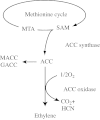Regulation of submergence-induced enhanced shoot elongation in Oryza sativa L
- PMID: 12509346
- PMCID: PMC4244991
- DOI: 10.1093/aob/mcf121
Regulation of submergence-induced enhanced shoot elongation in Oryza sativa L
Abstract
Rice (Oryza sativa L.) is the only cereal that can be cultivated in the frequently flooded river deltas of South-East and South Asia. The survival strategies used by rice have been studied quite extensively and the role of several phytohormones in the elongation response has been established. Deep-water rice cultivars can diminish flooding stress by rapid elongation of their submerged tissues to keep up with the rising waters. Other rice cultivars may react by mechanisms of submergence tolerance. Aerenchyma and aerenchymatous adventitious roots are formed that facilitate oxygen diffusion to prevent anaerobic conditions in the submerged tissues. This paper discusses the molecular aspects of the mechanism that leads to shoot elongation (leaves of seedlings and internodes), the regulation of which involves metabolism of, and interactions between, ethylene, gibberellins and abscisic acid. Finally, the importance of new techniques in future research is assessed. Current molecular technology can reveal subtle differences in gene activity between tolerant and non-tolerant cultivars, and identify genes that are involved in the regulation of submergence avoidance and tolerance.
Figures



Similar articles
-
Ethylene is not involved in adaptive responses to flooding in the Amazonian wild rice species Oryza grandiglumis.J Plant Physiol. 2015 Feb 1;174:49-54. doi: 10.1016/j.jplph.2014.09.012. Epub 2014 Oct 6. J Plant Physiol. 2015. PMID: 25462966
-
Distinct mechanisms for aerenchyma formation in leaf sheaths of rice genotypes displaying a quiescence or escape strategy for flooding tolerance.Ann Bot. 2011 Jun;107(8):1335-43. doi: 10.1093/aob/mcr086. Epub 2011 Apr 12. Ann Bot. 2011. PMID: 21489969 Free PMC article.
-
Time-Course Transcriptomics Analysis Reveals Key Responses of Submerged Deepwater Rice to Flooding.Plant Physiol. 2018 Apr;176(4):3081-3102. doi: 10.1104/pp.17.00858. Epub 2018 Feb 23. Plant Physiol. 2018. PMID: 29475897 Free PMC article.
-
[Submergence tolerance and Sub1 locus in rice].Yi Chuan. 2010 Sep;32(9):886-92. Yi Chuan. 2010. PMID: 20870609 Review. Chinese.
-
Life in the balance: a signaling network controlling survival of flooding.Curr Opin Plant Biol. 2010 Oct;13(5):489-94. doi: 10.1016/j.pbi.2010.08.002. Epub 2010 Aug 31. Curr Opin Plant Biol. 2010. PMID: 20813578 Review.
Cited by
-
Short-term complete submergence of rice at the tillering stage increases yield.PLoS One. 2015 May 22;10(5):e0127982. doi: 10.1371/journal.pone.0127982. eCollection 2015. PLoS One. 2015. PMID: 26001084 Free PMC article.
-
Surviving floods: Escape and quiescence strategies of rice coping with submergence.Plant Physiol. 2025 Feb 7;197(2):kiaf029. doi: 10.1093/plphys/kiaf029. Plant Physiol. 2025. PMID: 39880379 Free PMC article.
-
Identification of Lysine Histidine Transporter 2 as an 1-Aminocyclopropane Carboxylic Acid Transporter in Arabidopsis thaliana by Transgenic Complementation Approach.Front Plant Sci. 2019 Sep 11;10:1092. doi: 10.3389/fpls.2019.01092. eCollection 2019. Front Plant Sci. 2019. PMID: 31572413 Free PMC article.
-
Physiological and biochemical changes in plants under waterlogging.Protoplasma. 2010 May;241(1-4):3-17. doi: 10.1007/s00709-009-0098-8. Epub 2010 Jan 12. Protoplasma. 2010. PMID: 20066446 Review.
-
Metabolite and Phytohormone Profiling Illustrates Metabolic Reprogramming as an Escape Strategy of Deepwater Rice during Partially Submerged Stress.Metabolites. 2020 Feb 14;10(2):68. doi: 10.3390/metabo10020068. Metabolites. 2020. PMID: 32075002 Free PMC article.
References
-
- ArmstrongW, Brandle R, Jackson MB.1994. Mechanisms of flood tolerance in plants. Acta Botanica Neerlandica 43: 307–358.
-
- AzumaT, Hirano T, Deki Y, Uchida N, Yasuda T, Yamaguchi T.1995. Involvement of the decrease in levels of abscisic acid in the internodal elongation of submerged floating rice. Journal of Plant Physiology 146: 323–328.
-
- ChaeHS, Cho YG, Park MY, Lee MC, Eun MY, Kang BG, Kim WT.2000. Hormonal cross‐talk between auxin and ethylene differentially regulates the expression of two members of the 1‐amino cyclopropane‐1‐carboxylate oxidase gene family in rice (Oryza sativa L.). Plant and Cell Physiology 41: 354–362. - PubMed

